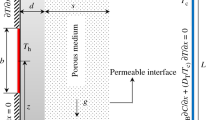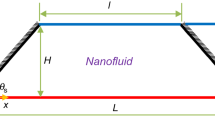Abstract
Following a series of discrepancies in the literature regarding the effects of nanoparticle concentration on the heat transfer rate, this paper proposes a simple homogeneous modeling for natural convection of nanofluids. The proposed modeling allows a custom choice of correlations for the nanofluid’s thermophysical properties, which proved to be very convenient in validations carried out for the case of natural convection inside a clear enclosure. The general heat transfer decreasing behavior for high concentrations of nanoparticles, previously observed in experimental and two-phase numerical works, was successfully represented. A very interesting and pioneer case study of laminar natural convection of nanofluids in a laterally heated enclosure with conductive solid blocks uniformly distributed within the enclosure was numerically investigated with the proposed modeling. To compute the nanofluids characteristics, Corcione’s correlations for thermal conductivity and dynamic viscosity for effective properties and generic correlations for density, specific heat and thermal expansion coefficient were employed. Therefore, it was possible to isolate the nanoparticle’s influence on the heat transfer rate, evaluated by the average Nusselt number. By isolating the nanoparticle’s parameters, the effects of diameter and material have been interpreted from the homogeneous solution. A parametric investigation was conducted by varying the number of blocks inside the enclosure and the effective Rayleigh number. A numerical correlation for the average Nusselt number was derived for a wide range of effective Rayleigh number and number of blocks. The model developed herein is suitable to other applications in which the total heat transfer rate needs to be computed.








Similar content being viewed by others
Abbreviations
- \(A\) :
-
Avogadro number
- \(c_{\text{p}}\) :
-
Specific heat at constant pressure (J/kg K)
- \({\text{CV}}\) :
-
Control volume
- \(d\) :
-
Mean diameter (m)
- \(g\) :
-
Acceleration of gravity (m/s2)
- \(H\) :
-
Height (m)
- \(k\) :
-
Thermal conductivity (W/m K)
- \(K\) :
-
Solid-to-nanofluid thermal conductivity ratio
- \(L\) :
-
Length (m)
- \(M\) :
-
Molar mass (kg/mol)
- \(n\) :
-
Normal direction unit vector
- \(N\) :
-
Number of blocks
- \(\overline{Nu}\) :
-
Average Nusselt number
- \(p\) :
-
Pressure (Pa)
- \(P\) :
-
Non-dimensional pressure
- \(Pr\) :
-
Prandtl number
- \(R\) :
-
Coefficient of determination
- \(Ra\) :
-
Rayleigh number
- \(Re\) :
-
Reynolds number
- \(T\) :
-
Temperature (K)
- \((u,v)\) :
-
Velocity components in (x, y) directions (m/s)
- \((U,\;V)\) :
-
Non-dimensional velocity components
- \((x,\;y)\) :
-
Spatial coordinates (m)
- \((X,\;Y)\) :
-
Non-dimensional spatial coordinates
- \(\alpha\) :
-
Thermal diffusivity (m/s2)
- \(\beta\) :
-
Thermal expansion coefficient (1/K)
- \(\delta\) :
-
Distance between blocks
- \(\delta_{\text{w}}\) :
-
Distance between blocks and the enclosure walls
- ϕ :
-
Porosity
- φ :
-
Nanoparticle concentration
- μ :
-
Dynamic viscosity (Pa s)
- v :
-
Kinematic viscosity (m/s2)
- θ :
-
Non-dimensional temperature
- ρ :
-
Density (kg/m3)
- ψ :
-
Stream function (kg/s)
- b :
-
Boltzmann
- B :
-
Brownian
- Calc:
-
Calculated
- C :
-
Cold
- eff:
-
Effective
- f :
-
Base fluid
- f 0 :
-
Base fluid at 0 K
- f p :
-
Base fluid at freezing point temperature
- H :
-
Hot
- min:
-
Minimum
- max:
-
Maximum
- nf:
-
Nanofluid
- np:
-
Nanoparticles
- p :
-
Particles
- ref:
-
Reference
- s :
-
Solid
- w :
-
Wall
References
Maxwell JC (1873) A treatise on electricity and magnetism, vol 1. Clarendon Press, Oxford
Choi SUS, Eastman JA (1995) Enhancing thermal conductivity of fluids with nanoparticles. ASME Int. Mech. Eng. Congr. Expo. 66(March):99–105
Das SK, Choi SUS, Yu W, Pradeep T (2007) Nanofluids: science and technology. Wiley, Hoboken
Haddad Z, Oztop HF, Abu-Nada E, Mataoui A (2012) A review on natural convective heat transfer of nanofluids. Renew. Sustain. Energy Rev. 16(7):5363–5378
Buongiorno J (2006) Convective transport in nanofluids. J. Heat Transf. 128(3):240–250
Vanaki SM, Ganesan P, Mohammed HA (2016) Numerical study of convective heat transfer of nanofluids: a review. Renew. Sustain. Energy Rev. 54(November):1212–1239
Putra N, Roetzel W, Das SK (2003) Natural convection of nano-fluids. Heat Mass Transf. und Stoffuebertragung 39(8–9):775–784
Wen D, Ding Y (2005) Formulation of nanofluids for natural convective heat transfer applications. Int. J. Heat Fluid Flow 26(6):855–864
Nnanna AGA (2007) Experimental model of temperature-driven nanofluid. J. Heat Transf. 129(6):697
Ho CJ, Liu WK, Chang YS, Lin CC (2010) Natural convection heat transfer of alumina-water nanofluid in vertical square enclosures: an experimental study. Int. J. Therm. Sci. 49(8):1345–1353
Li CH, Peterson GP (2010) Experimental studies of natural convection heat transfer of Al2O3/DI water nanoparticle suspensions (Nanofluids). Adv Mech Eng 2010:742739
Khanafer K, Vafai K, Lightstone M (2003) Buoyancy-driven heat transfer enhancement in a two-dimensional enclosure utilizing nanofluids. Int. J. Heat Mass Transf. 46(19):3639–3653
Oztop HF, Abu-Nada E (2008) Numerical study of natural convection in partially heated rectangular enclosures filled with nanofluids. Int. J. Heat Fluid Flow 29(5):1326–1336
Alipanah M, Ranjbar AA, Zahmatkesh A (2014) Numerical study of natural convection in vertical enclosures utilizing nanofluid. Adv Mech Eng 2014:392610
Öztop HF, Estellé P, Yan WM, Al-Salem K, Orfi J, Mahian O (2015) A brief review of natural convection in enclosures under localized heating with and without nanofluids. Int. Commun. Heat Mass Transf. 60(November):37–44
Garoosi F, Bagheri G, Talebi F (2013) Numerical simulation of natural convection of nanofluids in a square cavity with several pairs of heaters and coolers (HACs) inside. Int. J. Heat Mass Transf. 67:362–376
Pakravan HA, Yaghoubi M (2013) Analysis of nanoparticles migration on natural convective heat transfer of nanofluids. Int. J. Therm. Sci. 68:79–93
Choi SK, Kim SO, Lee TH, Dohee DH (2014) Computation of the natural convection of nanofluid in a square cavity with homogeneous and nonhomogeneous models. Numer. Heat Transf. Part A Appl. 65(4):287–301
Corcione M, Cianfrini M, Quintino A (2015) Enhanced natural convection heat transfer of nanofluids in enclosures with two adjacent walls heated and the two opposite walls cooled. Int. J. Heat Mass Transf. 88:902–913
Haddad Z, Abu-Nada E, Oztop HF, Mataoui A (2012) Natural convection in nanofluids: are the thermophoresis and Brownian motion effects significant in nanofluid heat transfer enhancement? Int. J. Therm. Sci. 57:152–162
Bejan A (2013) Convection heat transfer. Wiley, Hoboken
Merrikh AA, Lage JL (2005) Natural convection in an enclosure with disconnected and conducting solid blocks. Int. J. Heat Mass Transf. 48(7):1361–1372
Garoosi F, Talebi F (2017) Numerical analysis of conjugate natural and mixed convection heat transfer of nanofluids in a square cavity using the two-phase method. Adv. Powder Technol. 28(7):1668–1695
Lugarini A, Franco AT, Junqueira SLM, Lage JL (2018) Natural convection and surface radiation in a heated wall, c-shaped fracture. J Heat Transfer 140(8):082501
House JM, Beckermann C, Smith TE (1990) Effect of a centered conducting body on natural convection heat transfer in an enclosure. Numer. Heat Transf. Part A Appl. 18(2):213–225
Braga EJ, de Lemos MJS (2005) Laminar natural convection in cavities filled with circular and square rods. Int. Commun. Heat Mass Transf. 32(10):1289–1297
Bhave P, Narasimhan A, Rees DAS (2006) Natural convection heat transfer enhancement using adiabatic block: optimal block size and Prandtl number effect. Int. J. Heat Mass Transf. 49(21–22):3807–3818
Junqueira SLM, De Lai FC, Franco AT, Lage JL (2013) Numerical investigation of natural convection in heterogeneous rectangular enclosures. Heat Transf. Eng. 34(5–6):460–469
Raji A, Hasnaoui M, Naïmi M, Slimani K, Ouazzani MT (2012) Effect of the subdivision of an obstacle on the natural convection heat transfer in a square cavity. Comput. Fluids 68:1–15
Esfe MH, Arani AAA, Karimipour A, Esforjani SSM (2014) Numerical simulation of natural convection around an obstacle placed in an enclosure filled with different types of nanofluids. Heat Transf. Res. 45(3):279–292
Aminossadati SM, Ghasemi B (2012) Conjugate natural convection in an inclined nanofluid-filled enclosure. Int. J. Numer. Methods Heat Fluid Flow 22(4):403–423
Mahmoodi M, Sebdani SM (2012) Natural convection in a square cavity containing a nanofluid and an adiabatic square block at the center. Superlattices Microstruct. 52(2):261–275
Boulahia Z, Sehaqui R (2015) Numerical simulation of natural convection of nanofluid in a square cavity including a square heater. Int. J. Sci. Res. 4(12):1718–1722
Lage JL, Bejan A (1991) The Ra-Pr domain of laminar natural convection in an enclosure heated from the side1. Numer. Heat Transf. Part A Appl. 19(1):21–41
Lu G, Duan YY, Wang XD (2014) Surface tension, viscosity, and rheology of water-based nanofluids: a microscopic interpretation on the molecular level. J Nanoparticle Res 16(9):2564
Chen H, Ding Y, Tan C (2007) Rheological behaviour of nanofluids. New J Phys 9(10):367
Zhong ZY, Yang KT, Lloyd JR (1985) Variable property effects in laminar natural convection in square enclosure. J Heat Transfer 107:133–138
Maxwell IC (1904) A treatise on electricity and magnetism. Oxford University Press, London
Brinkman HC (1952) The viscosity of concentrated suspensions and solutions. J. Chem. Phys. 20(4):571
Corcione M (2011) Empirical correlating equations for predicting the effective thermal conductivity and dynamic viscosity of nanofluids. Energy Convers. Manag. 52(1):789–793
Kimura S, Bejan A (1983) The “heatline” visualization of convective heat transfer. J. Heat Transfer. 105(4):916–919
Patankar S (1980) Numerical heat transfer and fluid flow. CRC Press, Boca Raton
Van Doormaal JP, Raithby GD (1984) Enhancements of the simple method for predicting incompressible fluid flows. Numer. Heat Transf. 7(2):147–163
Leonard BP (1979) A stable and accurate convective modelling procedure based on quadratic upstream interpolation. Comput. Methods Appl. Mech. Eng. 19(1):59–98
Anderson WK, Bonhaus DL (1994) An implicit upwind algorithm for computing turbulent flows on unstructured grids. Comput. Fluids 23(1):1–21
Lage JL, Junqueira SLM, De Lai FC, Franco AT (2016) Aspect ratio effect on the prediction of boundary layer interference in steady natural convection inside heterogeneous enclosures. Int. J. Heat Mass Transf. 92:940–947
Acknowledgements
This work was supported by the Research Center for Rheology and Non-Newtonian Fluids (CERNN). The first author is grateful for the funding of National Council for Scientific and Technological Development (CNPq).
Author information
Authors and Affiliations
Corresponding author
Ethics declarations
Conflict of interest
The authors declare that they have no conflict of interest.
Additional information
Technical Editor: Francis HR Franca, Ph.D..
Publisher's Note
Springer Nature remains neutral with regard to jurisdictional claims in published maps and institutional affiliations.
Rights and permissions
About this article
Cite this article
Nascimento, G., Lugarini, A., Germer, E.M. et al. A simple homogeneous numerical solution for nanofluid natural convection in an enclosure with disconnected and conducting solid blocks. J Braz. Soc. Mech. Sci. Eng. 41, 262 (2019). https://doi.org/10.1007/s40430-019-1764-1
Received:
Accepted:
Published:
DOI: https://doi.org/10.1007/s40430-019-1764-1




